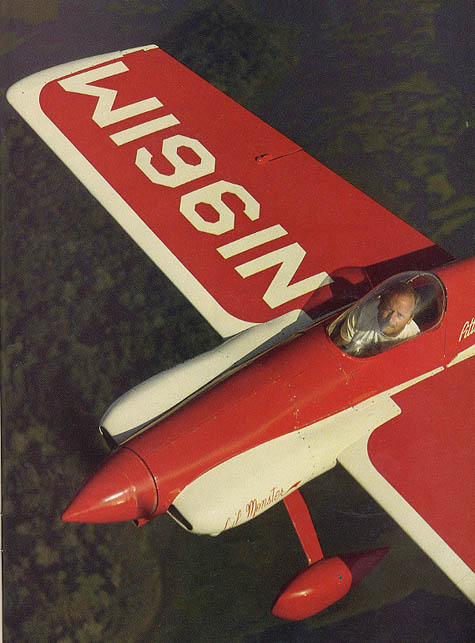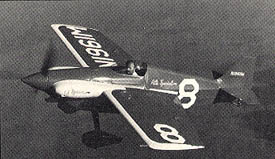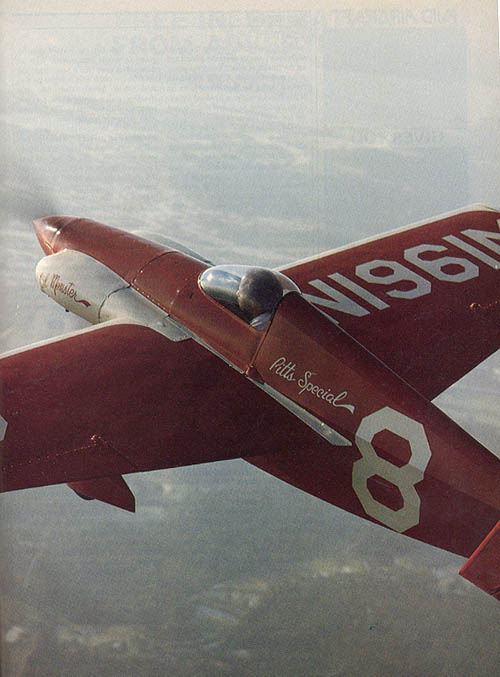
PIREP: Pitts Lil Monster (more color to come in a week or two)

Carl Pascarell, Air Progress, January, 1991
About ten months ago, I got a Call from Budd Davisson stating, "Guess what Jim and I just bought?" He was referring to Jim Clevenger of Wedell-Williams and Super T-6 fame and, when the two of them get together, there's no telling what they might find.
"I give up, Budd. What?"
"The Little Monster!"
"The what?!"
"The Pitts racer," replied Budd.
"Oh THAT Little Monster;' I said rather nonchalantly. Inwardly, I wracked my brain for a mental picture of the aircraft while Budd elaborated on the "find." I knew Curtis had built several Formula Oneish type racers (Goodyears, more precisely) during the 1940s, but I could only bring one aircraft, the Pellet, to mind. I only had a fuzzy recollection of a mid-wing aircraft Monster.
As the story unfolded, the Monster had been in storage in Oklahoma for almost 15 years before Jim captured the airplane and hauled it back to his home in North Carolina. His plan was to disassemble, clean and recover (essentially rebuild) the racer in time for the "Pitts Party" mentioned numerous times in this issue.
After hanging up the phone I did what I usually do when Budd throws me a curve, I immediately began researching the aircraft. The Monster was built around 1947 or '48 (even Curtis is unsure exactly when the plane was completed), and the aluminum wing, steel tube fuselage frame midget was designed around two things: The 190 cubic inch C-85 engine and the 5 ft 5 in Phil Quigley (the cockpit section was established by setting Phil up against the wall and chalk lofting his form!). Quigley was an accomplished race pilot and mechanic who did most of Curtis's development testing and racing in the early 1950s. The Monster with Phil at the controls raced a bunch in the Goodyear events of the era with a modicum of success.
To the best of my knowledge, the plane was last raced at Cape May, New Jersey, during the disastrous 1971 air races. Fastest recorded lap speeds were just over 240 mph - not bad even by today's standards.
After Curtis sold the aircraft, it passed through several hands before coming to rest in Oklahoma where James Dulin owned and flew the racer for almost 20 years. Detailed accounts of every Dulin flight accompanying the log books indicate nearly 400 hours logged in cross-country flights from Florida to California. Records also indicated two complete rebuilds as the result of almost identical hangar flooding instances. Clevenger subsequently acquired the Monster (autumn 1989) and set about restoring the craft to its current condition.
All this brings us to September 1990 - just a week before the Pitts Party - when I flew into Marion, North Carolina, to ostensibly fly the Monster to St. Augustine on the 24th. Jim's family was just finishing buttoning up the cowl when I walked into the hangar. Although I had seen plenty of pictures of the little racer, none really did the plane justice. The wing's broad chord and low aspect ratio tapered planform was just gorgeous. The sun was setting fast and we all pitched in to ready the bright red ship for its first flight before darkness.
 With the aircraft fueled, I climbed
in and over the wing, anxious to see how I'd fit in the Quigley-size
cockpit. I slid my feet forward under the main spar while lowering
myself down inside the 20-inch wide (!) fuselage. Something hung
my feet up before I got my feet all the way in and I fumbled around
unsuccessfully trying to get fitted into the cockpit. It suddenly
dawned that there was no obstacle at all. I had run up against
the rudder pedals! I didn't think I'd actually fit but, once in
with my knees up around my elbows and my back pressed hard against
the rear spar carry through, I found I could reach the needed
controls - barely. This is definitely an aircraft built for 15-minute
flights.
With the aircraft fueled, I climbed
in and over the wing, anxious to see how I'd fit in the Quigley-size
cockpit. I slid my feet forward under the main spar while lowering
myself down inside the 20-inch wide (!) fuselage. Something hung
my feet up before I got my feet all the way in and I fumbled around
unsuccessfully trying to get fitted into the cockpit. It suddenly
dawned that there was no obstacle at all. I had run up against
the rudder pedals! I didn't think I'd actually fit but, once in
with my knees up around my elbows and my back pressed hard against
the rear spar carry through, I found I could reach the needed
controls - barely. This is definitely an aircraft built for 15-minute
flights.
The much-advanced timing made starting difficult, but once started, the "hopped up" C-85 ran great - for about 30 seconds. We spent another 15 minutes propping before we got the engine running again. This time the engine ran for a whole minute be-fore quitting. Back in the hangar we went and off came the cowling, carb and fuel lines. Cleaned and checked, we reinstalled the units as the sun set. We pushed the plane back outside and it purred like a kitten. Just enough for the little light left and a quick flight around the pattern.
I taxied to the far end of the 3000 ft grass runway where I ran the engine at full power for a good minute before convincing myself it woud run well enough to continue as planned. The right mag checked a little rough but not bad and all else was in order. Lined up, I shoved the power in quickly and the C-85 responded well, gradually pulling the little racer faster and faster through the tall grass. The tail came up on its own at about 900 feet down the runway - just as we entered the lumpy midfield region.
Directional control was easy, thanks to the "dew wet" grass and the little racer handled the rough ground quite nicely - that is until a large ground swell launched us into the air about three seconds too early.
I wasn't quite sure the wing would bite and, being unsure about the stall characteristics, elected to let the aircraft settle back to the runway to accelerate just a bit more. The next bump launched us again into the air - this time in good aerodynamic shape so we could continue.
The aircraft accelerated low over the runway - the rpm steadily increasing with airspeed.
Approaching the end of the runway, I started a slow climbing turn back overhead the field, now shrouded in the long shadows of dusk. Three minutes later I leveled at 4500 feet, just in time to catch a last glimpse of the sun setting behind the mountains to the west. A quick bit of slow flight revealed no bad habits and the stall, although unannounced, broke straight and clean down around 75 indicated.

A mediocre flyby and chandelle set me up on downwind, trying to slow the plane to 90 - a good number for the first approach and landing. I turned base and found a full rudder sideslip necessary to keep the airplane from accelerating through 120. I had forgotten how clean some of these midgets are! Crossing the threshold low and flat, the airspeed hovered around 85-90. As the aircraft settled toward the grass, slight back pressure eased the descent and set the attitude at what I found was pretty close to three point. A little stick force reversal during the flare left me just a bit higher than I would have liked and the airplane shuddered its protest and dropped the last eight inches or so.
The rollout was short (I guess about 800 feet) and easily controlled directionally. A relatively successful flight although a post flight inspection revealed excessive blowby through the number four exhaust valve. A "midnight plus" valve grinding exercise followed - only to be rewarded with an unsatisfactory engine run at one in the morning. The blowby was back, stronger than ever and we could only guess that the "seat" was the real problem but without the appropriate grinding stones and equipment we (against our better judgment) skipped the process.
Wednesday morning with cylinder in hand we went off to the local valve grinding shop. Five hours later the cylinder was reinstalled. This time the compression checked out and two successful flights were undertaken - well, almost successful. The right mag was getting progressively worse and definitely not worth chancing a 2 1/2 hour trip south. The rest of the day was spent pouring through mag coils and condensers, trying to match the 20 year old mags. We were fortunate to find the appropriate replacement parts and managed one successful flight late in the evening. By unanimous agreement, we resolved to quit while ahead.
The next morning dawned cool and clear. One of the truly CAVU days when even the weather briefer don't have much to say. Fueled to capacity (22 gallons) and with baggage and pilot filling the cockpit, the Monster and I climbed lazily in the still morning air to 6500 feet. I set the power at what sounded about right and watched the airspeed needle settle on 160 mph. At this altitude the plane was truing almost 170.
Fuel burn couldn't be more than 6 1/2 gallon per hour, giving me almost three hours of endurance. I should be able to make the 350-mile trip to St. Augustine easily non-stop, although my butt was already offering serious objections.
The 50-mile plus visibility eliminated navigation as a worry and left the fuel system was my only concern. It's kind of an odd system: One fuselage tank (eight gallons) and two wing tanks (seven gallons apiece), each with their own on/off valve running to a single "T" at the gascolator. Only the fuselage tank has any sort of quantity gauge (a simple manometer). With all three valves open (you'd better hope you never have to reach them in flight) the fuel feeds pretty quickly from the main (fuselage) tank - until the head pressure equalizes in all three tanks. The fuel then feeds relatively equally from all three. Trouble is: If, for some reason, the wings don't feed then you are left with about two gallons with which to divert. Not a whole lot to say the least. I'm still not sure how I reasoned this out or why it worked, but if I pitched the nose up 30 degrees for several seconds, the main refilled rapidly to about 3/4. The method worked several times so I accepted it as fact.
With the fuel system under control and navigation almost too easy, I had a pleasant opportunity to just enjoy flying the aircraft. Response to control was definitely not as sharp as the Cassutt; softer, more relaxing really. Less deliberate and more gentle, well-harmonized and for sure more stable - particularly in yaw. The vertical surface (rudder and fin) act as one - probably because your feet are jammed hard against the rudder pedals. Aerodynamicists call this "stick fixed" stability (as opposed to stick free) and almost always makes for more stable response along that axis. This makes flying the airplane a whole lot less fatiguing on the long hauls.
The Monster was rigged well in pitch and, as is often the case with airplanes of similar genre, no elevator trim is supplied or required.
The truly enjoyable part of the flight lasted only 20 minutes or so, after which time my body decided it had had enough of this esoteric experience and began to object - vehemently! Never had I flown such an ergonomically uncomfortable airplane. Crammed fore and aft was bad enough but the narrowness of the cockpit allowed absolutely no twisting motion or side-to-side shifting. The plane's only redeeming comfort feature was headroom. Unfortunately, the only way I found to take advantage of this was to PlO the aircraft through the sky, alternately lifting and lowering my scrunched self on and off the floorboards. The things I have to do to fly something different!
I don't think I would ever be so happy to see St. Augustine.
Two hours and twenty minutes left me seriously numb and aching
for days afterward. Somehow though, the look on Curtis' face when
he first saw the resurrected Monster made the effort seem not
all that bad. In fact, the pain went away.